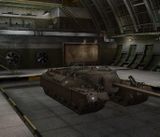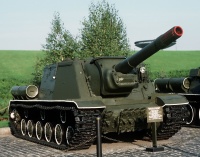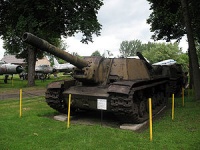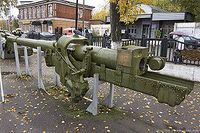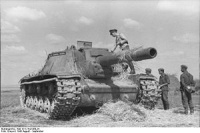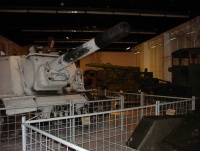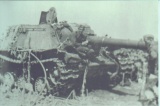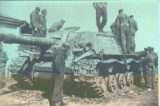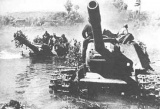SU-152
| Revision as of 02:00, 25 February 2012 | Revision as of 20:04, 28 February 2012 | |||
| Line 52: | Line 52: | |||
| }} | }} | |||
| {{Panel Gallery|Gallery| | {{Panel Gallery|Gallery| | |||
| + | [[image:T95_001.jpg|160px|T95_001]] | |||
| + | [[image:T95_001.jpg|160px|T95_001]] | |||
| + | [[image:T95_001.jpg|160px|T95_001]] | |||
| + | [[image:T95_001.jpg|160px|T95_001]] | |||
| }} | }} | |||
| {{History|info= | {{History|info= | |||
Revision as of 20:04, 28 February 2012
SU-152
| USSR | TD | Tier VII |
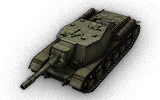
The SU-152 is a Soviet tier 7 tank destroyer. While having a very powerful gun and based on the KV-1S chassis, the SU-152 has relatively weak armor for a tank destroyer. It has the same problems as its heavy tank counterpart; low speed and maneuverability. Most heavies above it will find that they have no problems piercing the frontal armor, so it is best to use the low profile of this tank at range to make yourself a much harder target. It initially mounts a stinging 152mm as stock gun which is highly recommended you use only HE rounds as you will be facing alot of higher tier tanks. This gun can't penetrate most heavy tanks and with its poor accuracy, its not really a sniping tank unless mounted with the 122mm series gun. But beware; it has a small ammo storage, so for trigger happy folk, consider yourself warned. The upgraded 122mm gun has good penetration, decent damage and a high rate of fire for such a large weapon; being more accurate than the 152mm it truly brings out the potential of this tank.
- The SU-152 leads to ISU-152.
Modules
Historical Info
The SU-152 was a Soviet heavy self-propelled heavy howitzer used during World War II. It mounted a 152 mm gun-howitzer on the chassis of a KV-1S heavy tank. Later production used the IS tank chassis and was re-designated as the ISU-152. Because of its adopted role of as an impromptu heavy tank destroyer capable of knocking out the heaviest German armoured vehicles (Tiger and Panther tanks, and Elefant tank destroyers), it was nicknamed Zveroboy: "beast killer".
Development
The Stalingrad counteroffensive, Operation Uranus, exposed the Red Army's urgent need for mobile heavy guns. Primary targets for these guns were German fortifications in and around Stalingrad. At the time, Soviet front-line ground units did not possess sufficient firepower to deal with pillboxes and other fortifications.
Close support of artillery and combat engineers was an important factor in the success of Operation Uranus. However, with rare exceptions, all Soviet guns and howitzers at this time were towed rather than self-propelled. This lack of mobility proved to be greatly exacerbated by the absence of roads, the presence of deep snow cover, and a scarcity of artillery tractors. Towed guns were also highly vulnerable to counterattack while on the move, especially since they were often hauled by horses or their own crews. The 152 mm heavy howitzers were particularly difficult to maneuver; owing to their great weight and narrow steel wheels, were incapable of crossing rivers on anything but tank bridges, were prone to becoming hopelessly mired, and subsequently needing to be abandoned by their crews.
This situation did not satisfy the state authorities. In November 1942, the State Defense Committee ordered the development of a heavy self-propelled gun armed with the 152.4mm ML-20 howitzer. It should be noted that the Red Army had dedicated anti-fortification vehicles in the pre-war period, such as the KV-2 heavy tank armed with the 152.4 mm M-10 howitzer. The design proved unsatisfactory for numerous reasons, including a lethally-high silhouette, a sluggish and barely-functional manual turret traverse, a slow reload rate, and a high center of gravity which risked tipping the vehicle over when attempting to surmount even small obstacles. Mass production of KV-2s ceased in July 1941 and a few survived to November 1942. The new anti-fortification vehicle was designed with the same purpose in mind, but with higher mobility, heavier armor, reduced production cost, and the more powerful and accurate ML-20 152mm gun. Mounting the ML-20 in a turret was impossible due to its length and recoil, and it was eventually decided that the new vehicle should have a non-rotating gun mounted in a fixed casemate-style superstructure. Prior to the issue of the State Defense Committee order, there were several other anti-fortification vehicle projects, all of which were halted. Later in the war, these projects were restarted. In December 1942, three different designs of "pillbox killer" vehicles were introduced by various engineering groups from the major Soviet artillery and tank factories. All of these designs used the ML-20 gun as a primary armament on the KV-1S heavy tank chassis. After some discussion, the project of Joseph Yakovlevich Kotin was chosen for further mass production. This design successfully combined the ML-20 and KV-1S chassis with minimal expense. The entire project was designated "KV-14" and assembly of the first prototype (called "Object 236") began on December 31, 1942. It was completed after 25 days. Plant trials of "Object 236" began on January 25, 1943. After a number of successful plant tests, the more stringent state tests began. "Object 236" succeeded again. On February 14, 1943 the State Defense Committee accepted it for Red Army service and immediately launched it into mass production at the Chelyabinskiy Kirovskiy Zavod (Chelyabinsk Kirov Plant, ChKZ). The designation of the series of self-propelled guns was changed from KV-14 to SU-152. The ML-20 gun was slightly modified for mounting in the SU-152: some handles were moved for improved gunner comfort. This variant had the designation ML-20S. The muzzle velocity and external ballistics were identical to the original towed ML-20 gun.
Although designed with no consideration for the anti-tank role, the SU-152 proved to have surprisingly good anti-tank capabilities due to the ML-20S's extremely heavy HE projectiles. Standard doctrine for purpose-built AT guns of the period universally relied on small, dense solid projectiles propelled to high velocities, optimized for punching through armor. Since the SU-152, like all SU-series self-propelled guns, was not designed with tank killing in mind, no AP projectiles were issued to crews and no initial tests against armor were conducted. However, tests performed on captured Tiger tanks in early 1943 showed that the SU-152 was able to destroy them at any range with a fair degree of reliability (the only vehicle then in Soviet service capable of doing so) by simply blowing the turret off the vehicle through sheer blast effect. This fortuitous discovery spurred massive SU-152 production and the formation of self-propelled artillery units, which then functioned as ersatz heavy tank destroyer battalions.
After the launch of SU-152 mass production, the design was slightly modified to improve reliability. Initially, the SU-152 lacked a machine gun, which was recognized as a severe weakness in urban warfare and other close combat. To solve this problem, the DShK 12.7 mm anti-aircraft gun installation was developed in the summer of 1943. Some SU-152s received it after repair. The SU-152 was the last member of the KV family of tanks in mass production, and was replaced by the ISU-152 on the ChKZ production lines in December 1943. The exact number of SU-152s produced differs even in Russian sources, with the most common figures being 670 or 704. The SU-152s that survived World War II were withdrawn from Soviet Army service in 1954.
Construction and design
The SU-152 followed the same design as other Soviet self-propelled guns (except the SU-76). The fully-armored hull was divided into two compartments: a fighting compartment for the crew, gun, and ammunition in the front of the hull, and the engine and transmission separate in the rear. The hull was welded from rolled armour plates of different thickness — 75, 60, 30 and 20 mm. The front hull and superstructure armor plates were sloped for better vehicle protection: side armor was vertical. Lower front hull and rear armor plates were cylindrical, and were quite complex in their method of production. The ML-20S gun-howitzer was mounted slightly to the right of center with a limited traverse in a range of 12 degrees. Three of the crew were to the left of the gun: driver to the front, then gunner, and last the loader. The vehicle commander and breech mechanism operator were to the right.
The suspension consisted of twelve torsion bars for the six road wheels (each 600 mm in diameter) on each side. The drive sprockets were at the back. Each track was made up of 90 stamped links, each link of 608 mm width. The normal distance between two connected links was 160 mm. There were three internal fuel tanks, two in the crew area and one in the engine compartment, for a total capacity of 600–615 litres. These were usually enhanced by four unconnected external fuel tanks, which could hold an additional 360 litres of fuel. A 24-volt electrical power supply came from a 1 kW GT-4563A generator with a RRA-24 voltage relay regulator unit and four 6STE-128 accumulator batteries with a total capacity of 256 ampere-hours. This electrical equipment was common for many contemporary Soviet AFVs. The generator and accumulator batteries fed all other electrical equipment; the ST-700 electric starter motor, a radio set, an intercom, external and internal lights, and illumination of gunsight scales.
For observation from the interior, all roof hatches had periscopes and there were two gun sights; the telescopic ST-10 (СТ-10) and a panoramic sight. For crew communication a TPU-4-BisF intercom was fitted, and for inter-vehicle communication there was a single radio. The first-series SU-152 was equipped with the 9R, then 10R, and finally the 10RK-26 radio set. These radios were better than Soviet equipment at the start of the war, but remained inferior to German equipment. The crew was equipped with two PPSh submachine guns and twenty five F1 grenades for short-range self-defence.
Combat history
Although not designed for the role, the SU-152 proved to be a cheap, widely produced, and effective heavy tank killer, second only to the SU-100 as an antitank vehicle, as well as highly successful at its original role against infantry and fortifications. In combat, it was used for two distinct purposes; long-range artillery fire support during assaults by suppressing infantry and destroying pillboxes and AT guns, and as ersatz heavy tank destroyers (usually in ambush). The SU-152 was produced in large numbers throughout 1943, with the first SU-152s being issued to new heavy mechanized gun regiments raised in May 1943. The first regiment arrived at Kursk with only twelve guns, and was brought up to its full strength of twenty-one guns during the fighting (Zaloga 1984:165). Disadvantages of the vehicle included a low rate of fire due to the heavy ammunition, low ammunition storage (only 20 rounds), and a cramped and un-ergonomic crew compartment. Its armor protection was only adequate; the 65 mm of 30-degree sloped frontal armor was moderately greater than that of the T-34 medium tank, but still left it vulnerable frontally to the 88 mm KwK 36/43 guns of the Tiger and Elefant at long range and the 7.5 cm KwK 40 high-velocity gun of the Panzer IV and StuG III/IV at medium and short ranges (and from any range from the flanks or rear). The 152 mm gun, while having a maximum range far superior to the 88 mm, was still a corps-level heavy howitzer at heart, and had a much shorter accurate range than either the 88 mm or the 7.5 cm gun, while still being vulnerable to return fire at the same distance. This made it most effective for use in massed ambushes, where the German heavy tank's advantages could be nullified and the SU-152's one-shot kill potential could be best utilized.
Since it was intended as a self-propelled artillery piece rather than a true tank destroyer, the SU-152 was generally issued with standard HE rounds rather than armor-piercing projectiles. The 152mm HE round produced a massive blast that did not rely on velocity for its effectiveness, making them effective against any German tank, including the Tiger and Elefant (although with a somewhat decreased level of kill reliability over penetrating projectiles). It was renowned for its ability to rip the turret completely off a Tiger tank (at any range) by sheer blast effect alone, and numerous German AFVs were claimed as destroyed or damaged by SU-152 fire during the Battle of Kursk; for example, one Major Sankovskiy destroyed 10 German tanks (of unknown type) in a single day with his crew and his SU-152, and was awarded the title of Hero of the Soviet Union. camouflage
However, it proved less reliable at permanently destroying the Elefant heavy tank destroyer, which was impervious to any other Soviet gun and lacked a turret, making it more resistant to non-penetrating HE blasts. While the Soviets claimed at least seven German Elefants destroyed by SU-152 ambushes at Kursk, German after-action reports reveal that, while multiple Elefants were in fact knocked out, only one Elefant was completely destroyed; the rest being recovered after nightfall and quickly repaired, recrewed, and returned to battle. [1] This has been attributed to the gun's reliance on blast rather than penetration, which killed the crew and destroyed the vehicle's interior via concussion and spalling without harming the ammunition supply or chassis. In response, Soviet doctrine was changed by ordering SU-152 crews to continue firing on incapacitated vehicles until the turret was knocked off. [2]. After Kursk, the 152 mm BR-540 solid-core AP round was produced in small numbers and issued to heavy tank destroyer battalions in an effort to introduce a penetrating projectile, but the gun's inherent low velocity made the AP round no more accurate, and only moderately more effective than the standard HE round (which could also be used against infantry).
Following the SU-152's performance at Kursk, the SU-152 played a very important role in destroying German fortifications during the Operation Bagration counteroffensive, this being the vehicle's original design goal. From the second half of 1943 to the end of World War II, SU-152s were used on all Soviet fronts: from Finland to the Crimea. Due to combat losses and mass production ceasing in December 1943, the number of SU-152s in the Soviet Army decreased. Eventually, SU-152s were replaced by the more reliable and better-armored ISU-152, which used the same armament and ammunition in the same dual-purpose role.
Nickname etymology
Although the translation of the "Zveroboy" nickname as "beast killer" has been perpetuated in numerous books and articles, another theory posits that the actual meaning is derived from the Russian name for the St. John's Wort, a plant commonly used to treat various ailments: having nothing to do with the vehicle's actual role or performance.
Organisation
The SU-152 was used by the Independent Heavy Self-propelled Artillery Regiments (OTSAP, ОТСАП, in Russian, from Otdel'niy Tyazheliy Samokhodno-Artilleriyskiy Polk, Отдельный Тяжелый Самоходно-Артиллерийский Полк). Initially, each OTSAP had twelve SU-152s divided into three batteries of four vehicles. One KV-1S tank served as a commander's vehicle. After November 1943, the OTSAP organisation changed to 21 vehicles per regiment.
For more on unit organisation, see the corresponding chapter on the ISU-152 page.
- [BattleField.Ru]
- The Combat History of Schwere Panzer Abteilung 654, by Karlheinz Munch, pp.67-69
References
- [Wikipedia]
- Solyankin A. G., Pavlov M. V., Pavlov I. V., Zheltov I. G. (2005). Soviet Heavy Self-Propelled Guns 1941-1945. Moscow: «Exprint» (Солянкин А. Г., Павлов М. В., Павлов И. В., Желтов И. Г. Советские тяжёлые самоходные артиллерийские установки 1941-1945 гг.. — М.: ООО Издательский центр «Экспринт», 2005. — С. 48.) ISBN 5-94038-080-8
- Zaloga, Steven J., James Grandsen (1984). Soviet Tanks and Combat Vehicles of World War Two, pp 165–66. London: Arms and Armour Press. ISBN 0-85368-606-8.
- Snow Camouflage image from https://www.vhu.cz/en/stranka/vojenske-technicke-muzeum, Lešany, Czech Republic
| Light Tanks | MS-1 • BT-2 • Tetrarch • T-26 • T-60 • BT-7 • BT-SV • LTP • M3 Light • T-127 • T-46 • T-70 • A-20 • T-50 • T-80 • Valentine II • T-50-2 • MT-25 |
| Medium Tanks | A-32 • T-28 • Matilda IV • T-34 • T-34-85 • A-43 • KV-13 • T-43 • A-44 • T-44 • Object 416 • T-54 • Object 430 II • Object 283 • T-62A • Object 140 • Object 430 |
| Heavy Tanks | Churchill III • KV • KV-1 • KV-220 • KV-220 Beta-Test • KV-1S • KV-2 • T-150 • IS • KV-3 • IS-3 • IS-6 • KV-4 • KV-5 • IS-8 • ST-I • IS-4 • IS-7 |
| Tank Destroyers | AT-1 • SU-76 • SU-85B • SU-85 • SU-85I • SU-100 • SU-100Y • SU-100M1 • SU-122-44 • SU-152 • ISU-152 • SU-101 • Object 704 • SU-122-54 • Object 263 • Object 268 |
| Self-Propelled Guns | SU-18 • SU-26 • SU-5 • SU-122A • SU-8 • S-51 • SU-14-1 • SU-14-2 • 212A • Object 261
|





